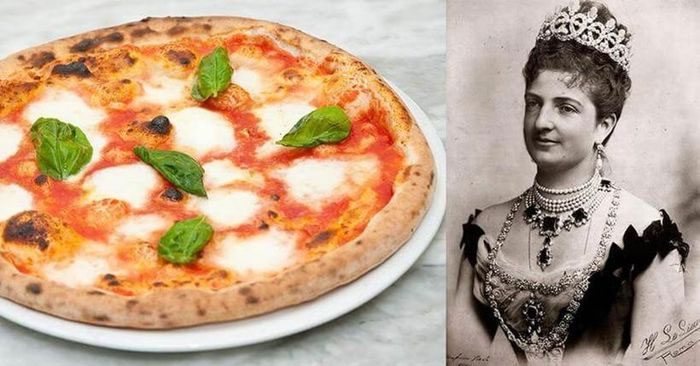Pizza is one of the most popular dishes in Italy as well as around the world.
Pizza is one of the most popular dishes in Italy as well as around the world. However, the true origins and who first created it remain a topic of much debate. Some documents suggest that the history of pizza stretches back to ancient times in Egypt, Rome, and Greece.
From Bread Thousands of Years Ago

Queen Margherita and her favorite pizza.
For thousands of years, people have combined various herbs, spices, vegetables, mushrooms, and meats to create dishes that not only sustain life but also tantalize the taste buds. Some of these combinations may have led to the creation of pizza. The name of this dish first appeared in the city of Gaeta (Italy) in 997.
Going further back in history, archaeologists have found evidence of fermented bread baked on stones dating back about 7,000 years in Sardinia. Gradually, ancient people began to add flavors by combining oil, vegetables, meats, and spices into their daily bread.
According to Science Trends, in the 6th century BC, Persian soldiers under King Darius I sprinkled dates and cheese on flatbread.
Meanwhile, ancient Chinese had a round flatbread called bing, while India produced a fatty bread known as paratha. Additionally, similar flatbreads can also be found in other South and Central Asian cultures, known as roti and naan.
Ancient Roman historians recorded various dishes in numerous documents. In the 3rd century, Cato the Elder wrote about a round flatbread topped with herbs and olives. By the 5th century, Virgil also described a similar dish.
Later archaeologists discovered cooking utensils from the ruins of Pompeii, which could have been used to make dishes similar to pizza, indicating they date back at least to the eruption of Mount Vesuvius around 72 AD.
The Evolution to Modern Pizza
Most historians today believe that modern pizza originated in Naples. This city began as a Greek settlement around 600, but by the 18th and 19th centuries, it had become an independent kingdom, prosperous yet with a high rate of poor laborers.

Raffaele Esposito is considered the “father” of modern pizza, and the plaque commemorating the 100th anniversary of pizza’s invention.
Pizza was invented around this time. Carol Helstosky, an Associate Professor of History at the University of Denver and author of the book *Pizza: A Global History*, explains that the poor laborers in Naples needed a cheap meal that they could eat quickly.
Pizza served this purpose well. The poor loved the bread topped with tomatoes, cheese, anchovies, oil, and garlic, while the higher social classes were appalled by what they considered a “disgusting” eating habit.
In 1805, Napoleon conquered Naples and ruled it until he was forced to abdicate in 1814. It wasn’t until 1861 that this kingdom officially became a city of Italy.
In 1889, King Umberto I of Italy and Queen Margherita visited Naples. The queen expressed her desire to sample the local specialties. The royal chef introduced Raffaele Esposito, the owner of Pizzeria Brandi, known for his delicious and enticing pizzas.
Esposito presented the queen with three pizzas: Pizza Marinara (with garlic), pizza with anchovies, and a pizza topped with tomatoes, mozzarella cheese, and basil. The queen adored the third pizza, so Esposito named it after her: Pizza Margherita.
After the royal visit to Naples, Esposito’s fame peaked, but the dish did not immediately gain popularity in his homeland. In fact, pizza thrived in America before the pizza craze spread throughout Italy.
In 1905, Gennaro Lombardi opened G. Lombardi’s on Spring Street in Manhattan, making his bakery one of the first licensed pizza businesses in America. Soon after, similar shops appeared across New York, Chicago, Boston, New Jersey, and anywhere else that Neapolitans settled.
The same phenomenon occurred in Europe. Immigrants from Naples brought their beloved dish everywhere. After World War II, pizza was no longer considered an “ethnic” food in America, and non-Neapolitans began to create their own versions according to their tastes.
In the 1950s, pizza continued to dominate the world. Pizza shop owner Rose Totino came up with the brilliant idea of selling frozen pizzas. In 1958, the first Pizza Hut opened in Wichita, Kansas.
A year later, the first Little Caesars opened in Garden City, Michigan. The following year, it was Domino’s in Ypsilanti. In 1962, a Greek-Canadian named Sam Panopoulos claimed to have invented Hawaiian Pizza.
As of 2022, the global pizza market is a $141.1 billion industry. In the U.S. alone, there are over 75,000 pizza outlets, more than half of which are independent stores.
In 2001, Pizza Hut made headlines by delivering a sausage pizza to the International Space Station (ISS). Just over a decade later, NASA-sponsored scientists developed a 3D printer that could produce a pizza in one minute and fifteen seconds. This was part of a project to create food for astronauts traveling to Mars.


















































